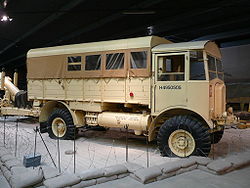AEC Matador
| AEC | |
|---|---|
|
AEC Matador Medium Artillery Tractor, Duxford
|
|
| Matador | |
| Manufacturer: | Associated Equipment Company |
| Production period: | 1938-1953 |
| Previous model: | none |
| Successor: | none |
| Technical specifications | |
| Engines: | AEC 7.6 liter diesel engine |
| Power: | 70 kW |
| Length: | 6020 mm |
| Width: | 2200 mm |
| Height: | 2720 mm |
| Perm. Total weight: | 7.75 t |

The AEC Matador was a British truck of World War II by the Associated Equipment Company in 1938 produced up 1,953th The matador formed the backbone of the British Army's transport and supply forces throughout the Commonwealth .
use
It was used both as a transport vehicle and as a tug for artillery, such as the 94 mm anti-aircraft gun Mk I. The Matador formed the intermediate piece between the Morris C8 for lighter weapons and the heavier Scammell Pioneer . Some variants of the Matador were built and parts were used for new vehicles. The loading plate and chassis, combined with the driver's cab of the AEC armored car and the Ordnance QF-6 pounder 7-cwt anti -tank gun, formed the AEC Mk I Deacon . Other variants were command vehicles equipped with radios, repair vehicles with cranes and additional winches, and tank trucks. A total of 9,000 AEC Matador were manufactured for the British Army and RAF .
properties
The Matador turned out to be a very versatile vehicle. The chassis was constructed in such a way that embankments and elevations could easily be negotiated by the front wheels positioned far forward. While most of the trucks of that time still had a simple drive, the Matador could already come up with all-wheel drive. The top speed was 48 km / h (30 mph). The rear superstructures can be converted quickly. A tarpaulin cover for the loading area was standardized. The command vehicle received a box with a loop antenna. The tank version had a three-axle drive and was able to carry 2500 gallons of fuel in its tank structure. In the repair version, a shortened box body was attached, there was a winch at the bow and stern, and a small crane on the loading area. Even after the war, the matador remained on duty. Discarded specimens were used everywhere and proved their worth in forestry, primarily because of their off-road driving properties.
See also
Web links
literature
- Chris Bishop: The encyclopedia of weapons of World War II , Metrobooks, New York 2002, ISBN 1586637622 , p. 97. ( available from Google Books )
- Wolfgang Fleischer: 1000 tanks and military vehicles. Naumann & Göberl Verlagsgesellschaft mbH, Cologne, ISBN 978-3-625-12224-1 .

